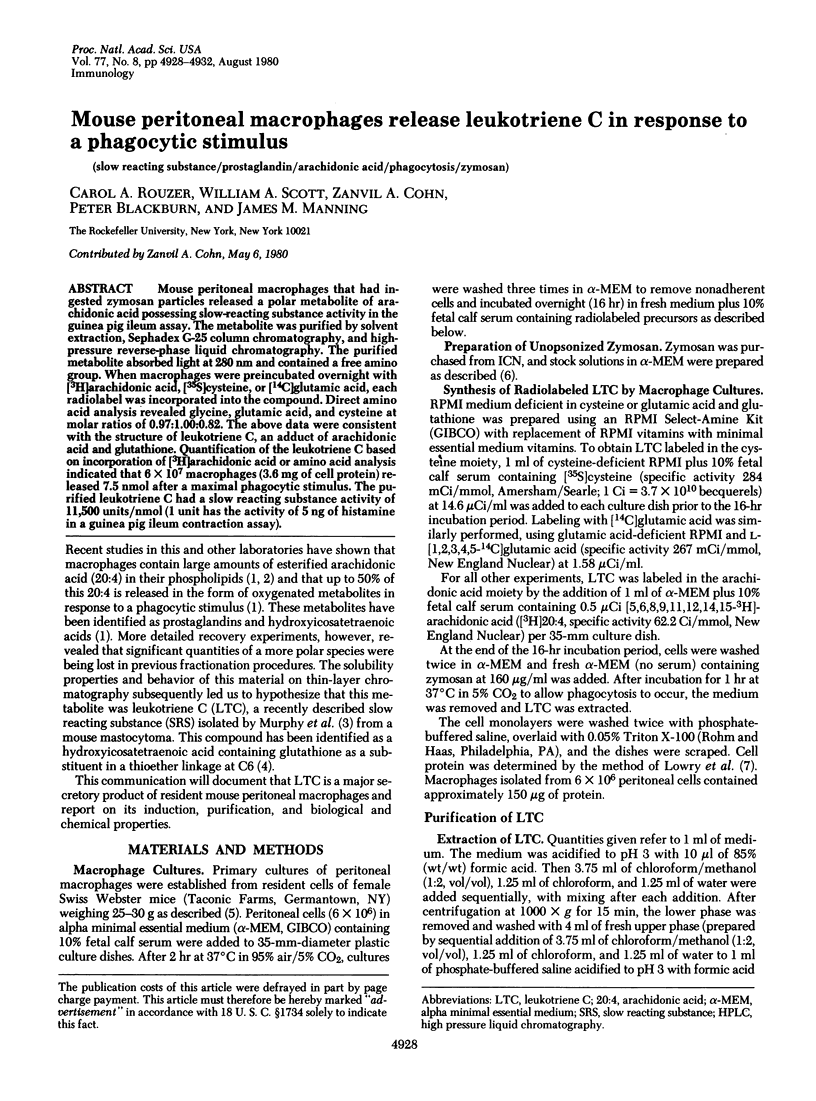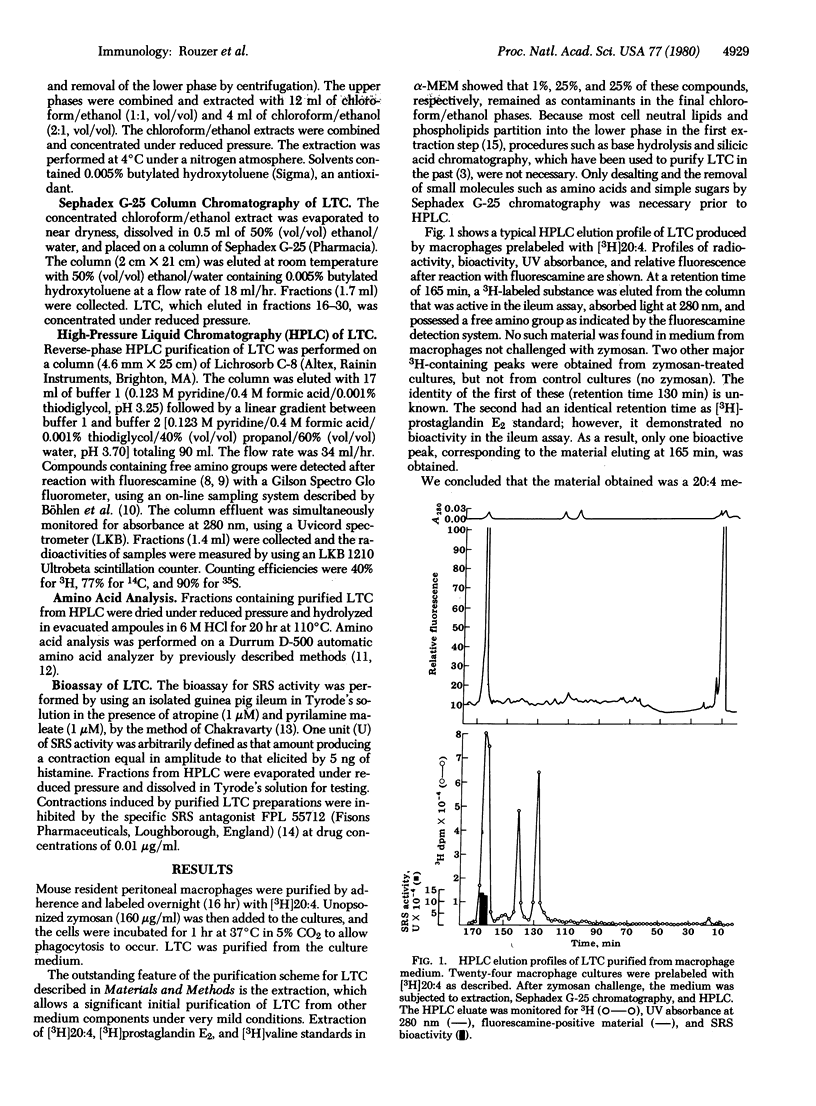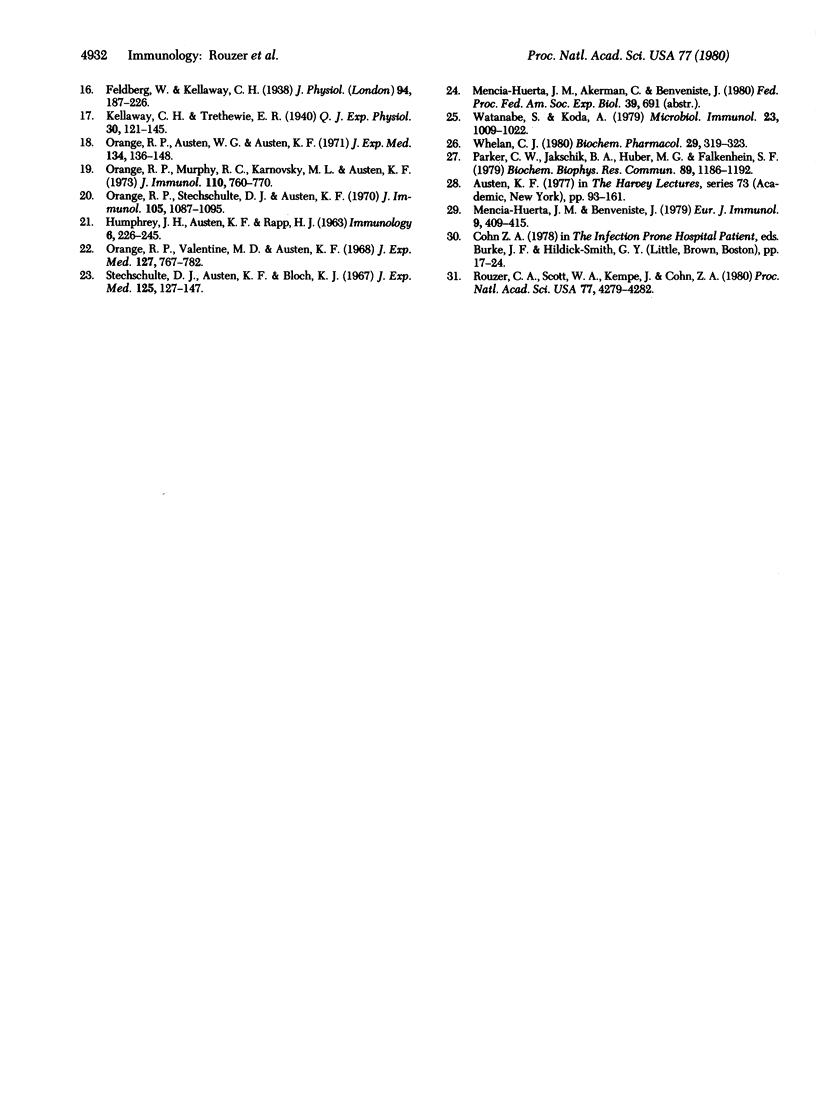Abstract
Mouse peritoneal macrophages that had ingested zymosan particles released a polar metabolite of arachidonic acid possessing slow-reacting substance activity in the guinea pig ileum assay. The metabolite was purified by solvent extraction, Sephadex G-25 column chromatography. The purified metabolite absorbed light at 280 nm and contained a free amino group. When macrophages were preincubated overnight with [3H]arachidonic acid, [35H]cysteine, or [14C]glutamic acid, each radiolabel was incorporated into the compound. Direct amino acid analysis revealed glycine, glutamic acid, and cysteine at molar ratios of 0.97:1.00:0.82. The above data were consistent with the structure of leukotriene C, an adduct of arachidonic acid and glutaathione. Quantification of the leukotriene C based on incorporation of [3H]arachidonic acid or amino acid analysis indicated that 6 X 10(7) macrophages (3.6 mg of cell protein) released 7.5 nmol after a maximal phagocytic stimulus. The purified leukotriene C had a slow reacting substance activity of 11,500 units/nmol (1 unit has the activity of 5 ng of histamine in a guinea pig ileum contraction assay).
Full text
PDF




Selected References
These references are in PubMed. This may not be the complete list of references from this article.
- Augstein J., Farmer J. B., Lee T. B., Sheard P., Tattersall M. L. Selective inhibitor of slow reacting substance of anaphylaxis. Nat New Biol. 1973 Oct 17;245(146):215–217. doi: 10.1038/newbio245215a0. [DOI] [PubMed] [Google Scholar]
- Austen K. F. Biologic implications of the structural and functional characteristics of the chemical mediators of immediate-type hypersensitivity. Harvey Lect. 1979;73:93–161. [PubMed] [Google Scholar]
- BLIGH E. G., DYER W. J. A rapid method of total lipid extraction and purification. Can J Biochem Physiol. 1959 Aug;37(8):911–917. doi: 10.1139/o59-099. [DOI] [PubMed] [Google Scholar]
- Bonney R. J., Wightman P. D., Davies P., Sadowski S. J., Kuehl F. A., Jr, Humes J. L. Regulation of prostaglandin synthesis and of the selective release of lysosomal hydrolases by mouse peritoneal macrophages. Biochem J. 1978 Nov 15;176(2):433–442. doi: 10.1042/bj1760433. [DOI] [PMC free article] [PubMed] [Google Scholar]
- Böhlen P., Stein S., Stone J., Udenfriend S. Automatic Monitoring of primary amines in preparative column effluents with fluorescamine. Anal Biochem. 1975 Aug;67(2):438–445. doi: 10.1016/0003-2697(75)90316-4. [DOI] [PubMed] [Google Scholar]
- CHAKRAVARTY N. A method for the assay of 'slow reacting substance'. Acta Physiol Scand. 1959 Aug 31;46:298–313. doi: 10.1111/j.1748-1716.1959.tb01760.x. [DOI] [PubMed] [Google Scholar]
- COHN Z. A., BENSON B. THE DIFFERENTIATION OF MONONUCLEAR PHAGOCYTES. MORPHOLOGY, CYTOCHEMISTRY, AND BIOCHEMISTRY. J Exp Med. 1965 Jan 1;121:153–170. doi: 10.1084/jem.121.1.153. [DOI] [PMC free article] [PubMed] [Google Scholar]
- Feldberg W., Kellaway C. H. Liberation of histamine and formation of lysocithin-like substances by cobra venom. J Physiol. 1938 Nov 14;94(2):187–226. doi: 10.1113/jphysiol.1938.sp003674. [DOI] [PMC free article] [PubMed] [Google Scholar]
- HUMPHREY J. H., AUSTEN K. F., RAPP H. J. In vitro studies of reversed anaphylaxis with rat cells. Immunology. 1963 May;6:226–245. [PMC free article] [PubMed] [Google Scholar]
- Hammarström S., Murphy R. C., Samuelsson B., Clark D. A., Mioskowski C., Corey E. J. Structure of leukotriene C. Identification of the amino acid part. Biochem Biophys Res Commun. 1979 Dec 28;91(4):1266–1272. doi: 10.1016/0006-291x(79)91203-8. [DOI] [PubMed] [Google Scholar]
- LOWRY O. H., ROSEBROUGH N. J., FARR A. L., RANDALL R. J. Protein measurement with the Folin phenol reagent. J Biol Chem. 1951 Nov;193(1):265–275. [PubMed] [Google Scholar]
- Mason R. J., Stossel T. P., Vaughan M. Lipids of alveolar macrophages, polymorphonuclear leukocytes, and their phagocytic vesicles. J Clin Invest. 1972 Sep;51(9):2399–2407. doi: 10.1172/JCI107052. [DOI] [PMC free article] [PubMed] [Google Scholar]
- Mencia-Huerta J. M., Benveniste J. Platelet-activating factor and macrophages. I. Evidence for the release from rat and mouse peritoneal macrophages and not from mastocytes. Eur J Immunol. 1979 May;9(5):409–415. doi: 10.1002/eji.1830090512. [DOI] [PubMed] [Google Scholar]
- Moore S. Amino acid analysis: aqueous dimethyl sulfoxide as solvent for the ninhydrin reaction. J Biol Chem. 1968 Dec 10;243(23):6281–6283. [PubMed] [Google Scholar]
- Murphy R. C., Hammarström S., Samuelsson B. Leukotriene C: a slow-reacting substance from murine mastocytoma cells. Proc Natl Acad Sci U S A. 1979 Sep;76(9):4275–4279. doi: 10.1073/pnas.76.9.4275. [DOI] [PMC free article] [PubMed] [Google Scholar]
- Orange R. P., Murphy R. C., Karnovsky M. L., Austen K. F. The physicochemical characteristics and purification of slow-reacting substance of anaphylaxis. J Immunol. 1973 Mar;110(3):760–770. [PubMed] [Google Scholar]
- Orange R. P., Stechschulte D. J., Austen K. F. Immunochemical and biologic properties of rat IgE. II. Capacity to mediate the immunologic releas of histamine an slow-reacting substance of anaphylaxis (SRS-A). J Immunol. 1970 Nov;105(5):1087–1095. [PubMed] [Google Scholar]
- Orange R. P., Valentine M. D., Austen K. F. Antigen-induced release of slow reacting substance of anaphylaxis (SRS-A rat) in rats prepared with homologous antibody. J Exp Med. 1968 Apr 1;127(4):767–782. doi: 10.1084/jem.127.4.767. [DOI] [PMC free article] [PubMed] [Google Scholar]
- Parker C. W., Jakschik B. A., Huber M. G., Falkenhein S. F. Characterization of slow reacting substance as a family of thiolipids derived from arachidonic acid. Biochem Biophys Res Commun. 1979 Aug 28;89(4):1186–1192. doi: 10.1016/0006-291x(79)92133-8. [DOI] [PubMed] [Google Scholar]
- Rouzer C. A., Scott W. A., Kempe J., Cohn Z. A. Prostaglandin synthesis by macrophages requires a specific receptor-ligand interaction. Proc Natl Acad Sci U S A. 1980 Jul;77(7):4279–4282. doi: 10.1073/pnas.77.7.4279. [DOI] [PMC free article] [PubMed] [Google Scholar]
- Stechschulte D. J., Austen K. F., Bloch K. J. Antibodies involved in antigen-induced release of slow reacting substance of anaphylaxis (SRS-A) in the guinea pig and rat. J Exp Med. 1967 Jan 1;125(1):127–147. doi: 10.1084/jem.125.1.127. [DOI] [PMC free article] [PubMed] [Google Scholar]
- Udenfriend S., Stein S., Böhlen P., Dairman W., Leimgruber W., Weigele M. Fluorescamine: a reagent for assay of amino acids, peptides, proteins, and primary amines in the picomole range. Science. 1972 Nov 24;178(4063):871–872. doi: 10.1126/science.178.4063.871. [DOI] [PubMed] [Google Scholar]
- Watanabe S., Koda A. Purification and some physicochemical properties of slow-reacting substance of anaphylaxis (SRS-A) from sensitized guinea pig lung. Microbiol Immunol. 1979;23(10):1009–1022. doi: 10.1111/j.1348-0421.1979.tb00531.x. [DOI] [PubMed] [Google Scholar]
- Whelan C. J. The partial purification of slow reacting substance of anaphylaxis from rat peritneal anaphylactic fluid and its separation from an arachidonic acid releasing substance. Biochem Pharmacol. 1980 Feb;29(3):319–323. doi: 10.1016/0006-2952(80)90507-9. [DOI] [PubMed] [Google Scholar]


